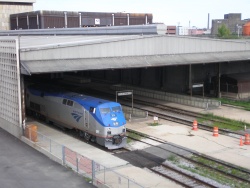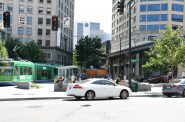Amtrak Ridership Hits All-Time High
Smaller cities drive increase as polls show voters overwhelmingly support federal support of passenger rail.
It’s been another year of ridership growth for Amtrak, despite the difficulties caused by Hurricane Sandy in the Northeast. In fiscal year 2013, the nation’s intercity rail service saw its 10th ridership increase in 11 years, carrying a record 31.6 million passengers [PDF].

Although the Hiawatha saw a slight decline in ridership during the 2013 fiscal year, ridership had increased 132 percent between 1997 and 2012.
The Northeast Corridor still accounts for a huge share of Amtrak’s total ridership, with 11.4 million trips, but the ridership on that segment was down slightly from the previous year. The major growth was in routes serving smaller cities.
Ridership was up 4 percent in Michigan, where construction to improve the speed of connections between Detroit and Chicago is entering the final phases. St. Louis to Chicago boardings were up 9.7 percent, indicating riders are responding to new investments in that line as well. One segment of track was recently upgraded from 79 mph to 110 mph service, and by the end of 2015 up to 75 percent of the route will receive similar improvements, shaving an hour off the trip between the two cities.
Meanwhile, the Pennsylvanian, serving Pittsburgh, Harrisburg and Philadelphia, saw a 3.3 percent ridership jump. And service in the San Joaquin Valley saw 6.6 percent more passengers. (Ridership for the Chicago to Milwaukee Hiawatha line decreased slightly in this period but has doubled over the last decade, prompting Gov. Scott Walker and the state Department of Transportation to support adding more trains to the line.)
News of the ridership high coincided with the release of a new poll of eight midwestern Congressional districts, showing support for Amtrak is much stronger than beltway political squabbles would indicate. DFM Research of St. Paul, Minnesota, interviewed 3,000 randomly selected residents of Illinois, Indiana, Missouri, Colorado, Kansas, and Iowa about their opinions on federal spending for the nation’s intercity passenger rail service, in a survey commissioned by SMART, a member union of the AFL-CIO’s Transportation Trades Department.
The survey and ridership data come as partisan gridlock and the government shutdown was threatening to bring Amtrak service to a halt.
This story originally ran on Streetsblog. Angie Schmitt is a newspaper reporter-turned planner/advocate who manages the Streetsblog Network from glamorous Cleveland, Ohio. She also writes about urban issues particular to the industrial Midwest at Rustwire.com.
Streetsblog
-
Car Culture Cements Suburban Politics
![Sprawl. Photo by David Shankbone (David Shankbone) [GFDL (http://www.gnu.org/copyleft/fdl.html) or CC-BY-SA-3.0 (http://creativecommons.org/licenses/by-sa/3.0/)], via Wikimedia Commons [ https://commons.wikimedia.org/wiki/File%3ASuburbia_by_David_Shankbone.jpg ]](https://urbanmilwaukee.com/wp-content/uploads/2017/10/1024px-Suburbia_by_David_Shankbone-185x122.jpg) Nov 23rd, 2018 by Angie Schmitt
Nov 23rd, 2018 by Angie Schmitt
-
Most Drivers Don’t Yield to Pedestrians
 Mar 22nd, 2018 by Angie Schmitt
Mar 22nd, 2018 by Angie Schmitt
-
Jobs Up Yet Driving Down in Seattle
 Feb 22nd, 2018 by Angie Schmitt
Feb 22nd, 2018 by Angie Schmitt

















Regarding the slight dip in Hiawatha ridership, a few things are worth noting. First, the number of people taking the train to Mitchell for the remarkably low fares has fallen as fare wars have mostly ended. The train-to-plane segment of total Hiawatha traffic was always relatively small, but the decrease in that segment is part of the overall slip. Second, we may be approaching the point where Hiawatha numbers can’t go much higher without more train. Peak-time trains are sometimes standing-room only, and that kind of experience encourages people to not rely on the train. Third, although the fiscal year ending 9/30/13 did see weaker demand on the Hiawatha last winter into spring, recent months have shown increases again. July set an all-time record at just under 80,000 passengers, and then August surpassed that by a few hundred.
If the talk of adding frequencies to the Hiawatha comes to pass, ridership will grow to meet that capacity. There’s a huge market in the Hiawatha corridor, and the more convenient and fast the service is the more of that market will opt for the train.
Oh, goody. More people are in love with Amtrak service. And no wonder: You pay your fare to ride, say, the Empire Builder service to the Twin Cities, and, for every rider, the taxpayers kick in $100.53 last year. See the details here: http://bit.ly/13Xm79i but the simple math is that the Empire Builder cost $112 million to operate in 2012, while it took in $57.7 million in revenue. The difference, $54.6 million, is what a government $17,000 billion in debt paid to keep fares low for the 543,000 people who took that train.
The Hiawatha to Chicago makes much more sense, I suppose. It cost $25.9 million to run last year, and it took in $23.7 million in fares and state aid. That meant taxpayers in, say, Knoxville chipped in $2.62 per person who rode the Hiawatha. Those Hiawatha passengers were grateful, I’m sure, and who wouldn’t be grateful to compel perfect strangers to kick in $2.62 every time you enjoy a train ride to Chicago?
Heck, get those passenger counts to surge — to double, if we’re starry-eyed enough — and maybe you’ll get it down to $2 per ride in subsidies taken from people who can’t afford Amtrak fares.
Go on: Tell me that your ride on Amtrak brings $2 worth of value to me, who did not ride the train. Add it up for me. Tell me about carbon “pollution,” even though global warming has flatlined for 15 years, or congestion, though we keep diverting money out of gas taxes so the highway fund can’t spend it on wider roads. Show me where I got $100.53 worth of value from every single rider on the Empire Builder. I’m sure the passengers got something out of it. But then why don’t we make them pay for the cost of their own trips?
@Son of Raw “But then why don’t we make them pay for the cost of their own trips?” Can we do that with people driving their cars too? For example at the national level we’ve been bailing out the Highway trust fund with general funds fairly regularly.. Doing the same thing here in Wisconsin as well. Not to me use property taxes to pay for roads too… How about air travel? Yup subsidy there too.
@Mr. Reid: Good point, though the odd thing about the federal highway trust fund is that fuel and tire taxes were perfectly adequate to keep it funded right up to 2008 (see the figures here, at table FE2: http://1.usa.gov/19kbra9
What happened then? A recession that hasn’t yet ended flattened the revenue, so it’s down from its peak of about $34 billion in 2007 and has lingered in the low 30s since. Federal highway spending, however, has spiked, leaping up as the administration asked a pliant Congress to transfer money in from the general fund as “stimulus.” In total, the government’s shifted about $41 billion into the highway fund: http://1.usa.gov/173zPZC
One simple answer: Stop believing in John Maynard Keynes. Spend within your means. And, yes, that means raising the fuel tax, which hasn’t budged in cents-per-gallon terms, since the 1990s. Put mileage-charge trackers on Volts and Leafs so they pay their fair share, too.
As for the Wisconsin highway trust, the flow has been the other way, as the Legislature’s nonpartisan accountants will tell you: http://1.usa.gov/H4JNo4 The transportation fund has repeatedly been raided, then backfilled with general obligation bonds to be repaid in part with gas-tax money. In this way, it’s been Wisconsin drivers who were subsidizing the rest of government up until the dawn of Walker.
And your property taxes do pay something for local streets — anything less than a county, state or federal highway. And? Those streets aren’t about drivers. They’re about letting firetrucks and the mailman and the city water crew reach your house. They’re access to your property, which is why they’re appropriately on the property tax.
But details aside, Mr. Reid, the fact is that the car customarily has paid its way (and more, as gas taxes also cover federal transit aid). It can and will again, assuming Obama’s recession eventually ends, with a few tweaks to taxation. But paying its own way is a much more existential problem for Amtrak, which relies on subsidies from non-users to make its fares tolerable to paying customers.
Son of Raw says: “The [Wisconsin] transportation fund has repeatedly been raided, then backfilled with general obligation bonds to be repaid in part with gas-tax money. In this way, it’s been Wisconsin drivers who were subsidizing the rest of government up until the dawn of Walker.”
Going forward, NONE of the debt service (interest and principal) on these bonds is being paid out of transportation funds. This has been the case since mid-2005 (well before “the dawn of Walker”).
Transportation money was only used to service the debt on these bonds in the 2003-2005 biennium, and the grand total of this transportation fund debt service spending was $43.9 million (barely enough to widen 4 lanes of rural interstate to 6 lanes).
This $43.9 million is dwarfed by the $149.5 million that was taken (raided) from the Milwaukee streetcar account in 1999 to help fund the Marquette interchange reconstruction (even back then–well before 2008, gas taxes weren’t bringing in enough to maintain the roads).
@Tom D, indeed, as you state “even back then–well before 2008, gas taxes weren’t bringing in enough to maintain the roads” – a report from Pew a few years ago reported that in 1967 71% of road costs were paid by user fees. That fell to 61% in 1997 and further to 51% in 2007.
@Eric S Thanks I was looking for that report.
I personally think it would be a good idea to increase gasoline and diesel taxes at both the federal and state level. Both of these fuels contribute to CO2 emissions, but admittedly, so do the coal and natural gas used to run the power plants that produce most of our electricity. AFAIK, the price of most of these fuels is going down, and with newer vehicles being in general more efficient, I would argue that the economy can likely afford some amount of additional taxation on fuels.
I like trains and plan on taking the Amtrak from St. Louis to Chicago at some point, perhaps to Milwaukee also, but it sounds like it might be a bit crowded at times between Chicago and Milwaukee. The point about the $17 trillion in US debt is always worth keeping in mind, but I would argue that the cost of Amtrak is a pittance amongst the enormous sums being spent on Social Security, Medicare, and Medicaid. Even though I tend to be a hawk on defense and have an intense interest in the military, I think spending in this area also needs to be reined in. These should be the real targets for fiscal reform IMO, but I predict that programs like Amtrak and other sorts of discretionary spending will likely be taking substantial hits in the future. I don’t think it’s the best course for the country.
“But details aside, Mr. Reid, the fact is that the car customarily has paid its way (and more, as gas taxes also cover federal transit aid).”
Absolute nonsense. First, the Federal Gasoline Tax hasn’t been rasied in about 20 years, and with cars getting better MPG and costs going up for construction, the shortfall is dramatic, and the amount of projects which are deferred due to the shortfall of tax money is the hidden number. Throw in whatever extra monies aren’t covered for local/state projects through state gas tax, and you’re talking about some real cash.